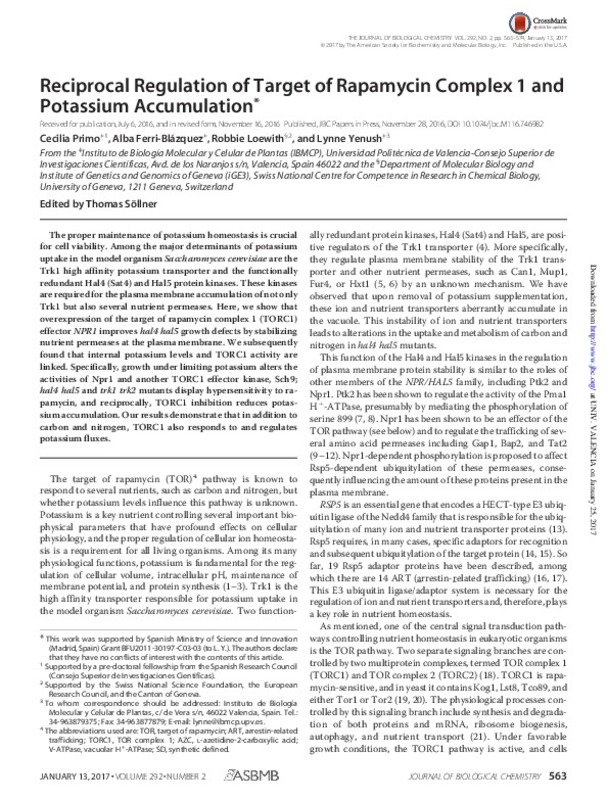JavaScript is disabled for your browser. Some features of this site may not work without it.
Buscar en RiuNet
Listar
Mi cuenta
Estadísticas
Ayuda RiuNet
Admin. UPV
Reciprocal regulation of Target of Rapamycin Complex 1 and potassium accumulation
Mostrar el registro sencillo del ítem
Ficheros en el ítem
| dc.contributor.author | Primo Planta, Cecilia
|
es_ES |
| dc.contributor.author | Ferri-Blazquez, Alba
|
es_ES |
| dc.contributor.author | Loewith, Robbie
|
es_ES |
| dc.contributor.author | Yenush, Lynne
|
es_ES |
| dc.date.accessioned | 2018-09-25T07:07:54Z | |
| dc.date.available | 2018-09-25T07:07:54Z | |
| dc.date.issued | 2017 | es_ES |
| dc.identifier.issn | 0021-9258 | es_ES |
| dc.identifier.uri | http://hdl.handle.net/10251/108052 | |
| dc.description.abstract | [EN] The proper maintenance of potassium homeostasis is crucial for cell viability. Among the major determinants of potassium uptake in the model organism Saccharomyces cerevisiae are the Trk1 high affinity potassium transporter and the functionally redundant Hal4 (Sat4) and Hal5 protein kinases. These kinases are required for the plasma membrane accumulation of not only Trk1, but also several nutrient permeases. Here, we show that overexpression of the Target of Rapamycin Complex 1 (TORC1) effector NPR1 improves hal4 hal5 growth defects by stabilizing nutrient permeases at the plasma membrane. We subsequently found that internal potassium levels and TORC1 activity are linked. Specifically, growth under limiting potassium alters the activities of Npr1 and another TORC1 effector kinase, Sch9; hal4 hal5 and trk1 trk2 mutants display hypersensitivity to rapamycin; and, reciprocally, TORC1 inhibition reduces potassium accumulation. Our results demonstrate that in addition to carbon and nitrogen, TORC1 also responds to and regulates potassium fluxes. | es_ES |
| dc.description.sponsorship | This work was supported by Spanish Ministry of Science and Innovation (Madrid, Spain) Grant BFU2011-30197-C03-03 (to L. Y.). The authors declare that they have no conflicts of interest with the contents of this article. Supported by a pre-doctoral fellowship from the Spanish Research Council (Consejo Superior de Investigaciones Cientificas). Supported by the Swiss National Science Foundation, the European Research Council, and the Canton of Geneva. | |
| dc.language | Inglés | es_ES |
| dc.publisher | American Society for Biochemistry and Molecular Biology | es_ES |
| dc.relation.ispartof | Journal of Biological Chemistry | es_ES |
| dc.rights | Reserva de todos los derechos | es_ES |
| dc.subject | Target of Rapamycin | es_ES |
| dc.subject | Potassium ion transport | es_ES |
| dc.subject | Membrane trafficking, Endocytosis | es_ES |
| dc.subject.classification | BIOQUIMICA Y BIOLOGIA MOLECULAR | es_ES |
| dc.title | Reciprocal regulation of Target of Rapamycin Complex 1 and potassium accumulation | es_ES |
| dc.type | Artículo | es_ES |
| dc.identifier.doi | 10.1074/jbc.M116.746982 | es_ES |
| dc.relation.projectID | info:eu-repo/grantAgreement/MICINN//BFU2011-30197-C03-03/ES/PAPEL DEL TRAFICO DE PROTEINAS EN LA HOMEOSTASIS DE IONES Y NUTRIENTES EN LEVADURA Y PLANTAS/ | es_ES |
| dc.rights.accessRights | Abierto | es_ES |
| dc.contributor.affiliation | Universitat Politècnica de València. Departamento de Biotecnología - Departament de Biotecnologia | es_ES |
| dc.contributor.affiliation | Universitat Politècnica de València. Instituto Universitario Mixto de Biología Molecular y Celular de Plantas - Institut Universitari Mixt de Biologia Molecular i Cel·lular de Plantes | es_ES |
| dc.description.bibliographicCitation | Primo Planta, C.; Ferri-Blazquez, A.; Loewith, R.; Yenush, L. (2017). Reciprocal regulation of Target of Rapamycin Complex 1 and potassium accumulation. Journal of Biological Chemistry. 292(2):563-574. https://doi.org/10.1074/jbc.M116.746982 | es_ES |
| dc.description.accrualMethod | S | es_ES |
| dc.relation.publisherversion | http://doi.org/10.1074/jbc.M116.746982 | es_ES |
| dc.description.upvformatpinicio | 563 | es_ES |
| dc.description.upvformatpfin | 574 | es_ES |
| dc.type.version | info:eu-repo/semantics/publishedVersion | es_ES |
| dc.description.volume | 292 | es_ES |
| dc.description.issue | 2 | es_ES |
| dc.identifier.pmid | 27895122 | |
| dc.identifier.pmcid | PMC5241732 | |
| dc.relation.pasarela | S\331155 | es_ES |
| dc.contributor.funder | Ministerio de Ciencia e Innovación | es_ES |








